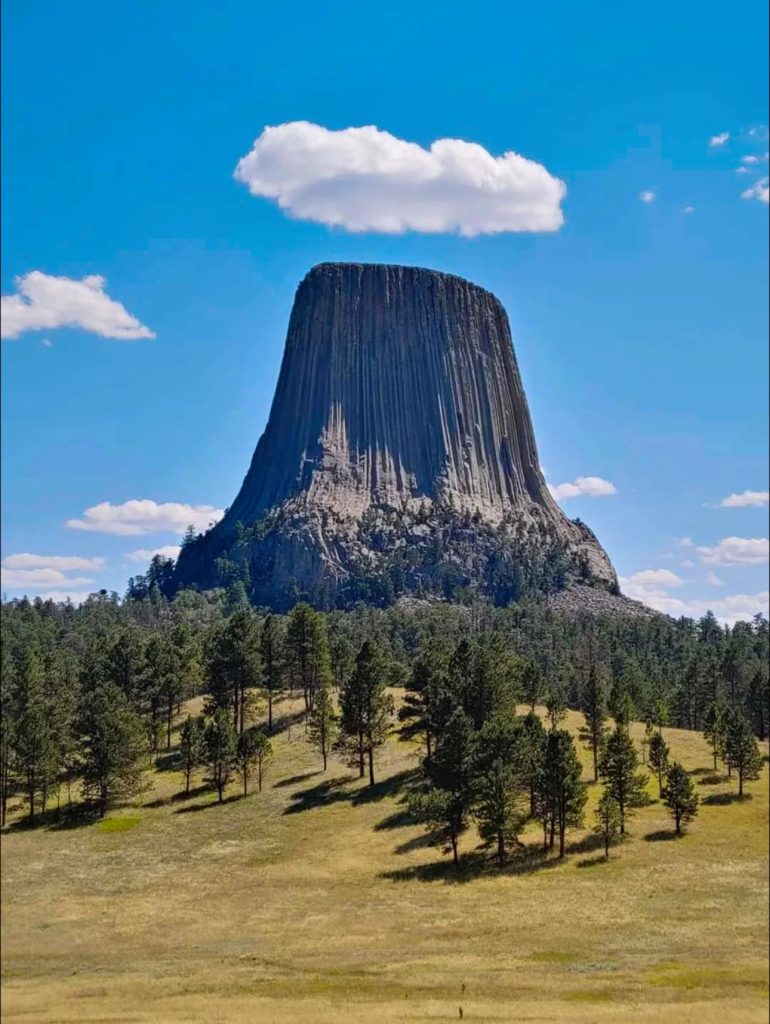Rising from the vast expanse of northeastern Wyoming’s rolling plains, Devils Tower commands both the land and the imagination of those who encounter it. This immense geological formation—standing over 1,200 feet tall from its base—has inspired awe for centuries, from ancient Indigenous tribes who wove legends around its towering columns to modern scientists seeking to unlock the secrets of its origin. With a form that defies simple explanation and a presence that feels almost otherworldly, Devils Tower is not only a natural wonder but also a powerful reminder of Earth’s dynamic geological history.

Long before the Tower’s dramatic rise above the plains, the region looked dramatically different. Around 200 million years ago, this land lay beneath an inland sea. Over countless millennia, sediment settled to the ocean floor, slowly compacting into layers of shale, sandstone, and limestone. These sedimentary deposits became the geological foundation upon which Devils Tower would eventually be formed. As the Earth’s surface shifted and the sea retreated, these rock layers were exposed to the forces of time and weather, setting the stage for monumental change.
The true transformation began roughly 50 to 60 million years ago, during a period of intense tectonic activity in western North America. As the Rocky Mountains and nearby Black Hills began to rise under the immense pressure of colliding tectonic plates, molten rock—magma—forced its way upward through the layers of sediment. This intrusion of magma, however, never reached the surface to erupt as a volcano. Instead, it became trapped beneath the Earth’s crust, where it cooled slowly and began to crystallize into a hard, durable igneous rock known as phonolite porphyry.
For decades, scientists have debated exactly how this process gave rise to Devils Tower’s distinct shape. Several theories have emerged since the late 1800s. Some geologists argue that the Tower is the remnants of a laccolith—a dome-shaped mass of magma that bulged upward but never erupted. Others suggest it could be a volcanic plug, the solidified core of an ancient volcano whose outer layers eroded away. Still others propose it formed as part of a maar-diatreme volcano, an explosive underground eruption that left behind a vertical column of hardened magma. Despite the differing opinions, all agree that this unique formation was born from the intense heat and pressure beneath the Earth’s surface, shaped by forces we are only beginning to fully understand.
What is not debated is the vital role erosion played in revealing the Tower we see today. Over tens of millions of years, wind, rain, and flowing water wore away the softer sedimentary rocks surrounding the Tower. This relentless erosion eventually unveiled the more resistant igneous rock at the core, which stood firm even as the surrounding landscape slowly disappeared. Today, the exposed Tower rises dramatically above the Belle Fourche River valley, a testament to the power of natural erosion and the resilience of stone.
One of Devils Tower’s most striking features is its columnar jointing—massive vertical columns that give the Tower its iconic, fluted appearance. These columns, many of them hexagonal or polygonal in shape, formed as the magma cooled and contracted. The slow cooling process caused the rock to crack in predictable patterns, creating columns that can be up to 10 feet wide and over 600 feet tall. While columnar jointing can be seen in other geological formations around the world—such as the Giant’s Causeway in Ireland or the basalt columns of Iceland—the sheer scale and symmetry of Devils Tower’s columns are unparalleled.
Even today, Devils Tower is not immune to the forces of nature. Small pieces of rock regularly break away from the Tower’s face, and the large boulder fields surrounding its base are silent witnesses to ancient collapses. Interestingly, in all of recorded history, no major column has ever fallen from the Tower. Its silhouette, bold and undisturbed, continues to dominate the landscape just as it has for thousands of years.
Beyond its geological significance, Devils Tower holds deep cultural and spiritual meaning. For many Native American tribes, including the Lakota, Cheyenne, and Kiowa, the Tower is sacred. Legends tell of children chased by bears, who climbed a rock that grew into the sky, the claw marks left behind forming the Tower’s vertical lines. This intertwining of myth and landscape highlights how deeply Devils Tower is woven into the human experience, not just as a geological formation but as a symbol of mystery and reverence.
Designated as the United States’ first national monument in 1906 by President Theodore Roosevelt, Devils Tower attracts thousands of visitors each year, from hikers and climbers to those simply seeking to marvel at its grandeur. Scientists continue to study the Tower, hoping to uncover more about its formation, while visitors are left with a sense of awe at its enduring presence.
Devils Tower stands not only as a monument to geological forces but also as a bridge between the scientific and the spiritual, the ancient and the modern. Its existence challenges us to consider the immense scale of time and the powerful forces that have shaped—and continue to shape—our planet. In gazing upon the Tower, we connect with a narrative that stretches back millions of years, yet remains as captivating today as ever.
As the sun sets over the Wyoming plains and the Tower casts its long shadow across the land, it reminds us of Earth’s ability to surprise, to inspire, and to endure. Through its silent testimony, Devils Tower offers not just a glimpse into the planet’s fiery past, but also a moment to reflect on our place in the vast, ever-changing story of the natural world.





